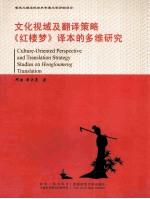

文化视域及翻译策略 《红楼梦》译本的多维研究PDF电子书下载
- 电子书积分:15 积分如何计算积分?
- 作 者:邱进,周洪亮著
- 出 版 社:西南师范大学出版社
- 出版年份:2011
- ISBN:
- 页数:476 页
Part One Translation and Culture:Contrastive Study on the Yangs'and Hawkes'VersionsChapter One Introduction 3
1.1 Hongloumeng and Its English Translation 3
1.2 The Research Questions 9
1.3 The Format of This Book 11
Chapter Two Literature Review 14
2.1 Previous Researches into the Translation of Hongloumeng 14
2.2 The Functional Approach of Translation Study 17
2.3 Previous Researches of Functionalism in Literary Translation 25
Chapter Three Research Methodology 28
3.1 A Sketchy View on the Action Theory 28
3.2 The Functionalist Translation Theory 31
3.3 Peter Newmark's Semantic Translation and Communicative Translation 56
3.4 Language,Culture and Translation Strategy from a Cultural Studies Perspec-tive 59
3.5 The Validity of the Theories Applied to This Study 68
Chapter Four Contrastive Study of the Translation of Culture-Specific Elements in the Two Versions 71
4.1 Introduction 71
4.2 Different Roles and Functions in the Translational Actions of Hongloumeng 72
4.3 Different Translation Briefs and Skoposi of the Two Versions 73
4.4 Contrastive Study of the Translation of Culture—Specific Elements of the Two Versions 82
Chapter Five Optimal Balance between the Two Translation Strategies:Foreignization vs.Domestication 139
5.1 The Yangs' Main Translation Methods Underpinned by Their Translation Strategy 139
5.2 Hawkes' Main Translation Methods Based on His Translation Strategy 140
5.3 Appropriate Degree of Foreignization and Domestication in the Two Versions 142
5.4 Major Findings 154
Appendix:《红楼梦》两种英译本异化与归化的调查问卷 163
Chapter Six Poetry Translation in Hongloumeng 173
6.1 Poetry Translation 173
6.2 Poetry in Hongloumeng 178
6.3 Functionalist Approach to Poetry Translation in Hongloumeng 181
6.4 Other Factors Affecting the Translator's Choice of Translation Strategy 212
Chapter Seven Translation of Lantern Riddles in Hongloumeng 217
7.1 Introduction 217
7.2 Lantern Riddles in Hongloumeng 218
7.3 A General Notion of the Translator's Subjectivity 223
7.4 A Contrastive Study on Lantern Riddles Translation from the Perspective of the Translator's Subjectivity 233
7.5 Further Discussion about the Translator's Subjectivity 253
Chapter Eight Translation of Two—Part Allegorical Sayings in Hongloumeng 255
8.1 Introduction 255
8.2 Description of Two—Part Allegorical Sayings 256
8.3 Nida's Equivalence Theory 258
8.4 Translation Methods Adopted in the Two Versions 261
8.5 Approaches to Image—Rendering 267
Chapter Nine Translation of Cultural Default in Hongloumeng 270
9.1 Cultural Default 270
9.2 Analysis of Cultural Default in Hongloumeng 275
9.3 Translation of Cultural Default in Hongloumeng 282
Chapter Ten The Impact of the Translator's Hybrid Cultural Identity on Cultural Translation of Hongloumeng 303
10.1 Introduction 303
10.2 The Hybridity of Cultural Identity 304
10.3 The Hybridity of Cultural Identity of Hongloumeng Translators 313
10.4 The Hybridity of Cultural Identity and Manipulation of Cultural Informa-tion in Hongloumeng Translation 315
Part Two Sociosemiotics and Stylistics:The Study on A Dream of Red MansionsChapter Eleven Translation of Color Terms in A Dream of Red Mansions 329
11.1 Introduction 329
11.2 Translatability and Untranslatability of Color Terms 330
11.3 The Categorization of Color Terms in Hongloumeng 333
11.4 Color Images in Hongloumeng 335
11.5 Translation Principles of Color Terms and Color Images in Hongloumeng 343
Chapter Twelve Translation of Fuzzy Expressions in A Dream of Red Mansions 349
12.1 Introduction 349
12.2 The Notion of Fuzzy Equivalence 350
12.3 Translation of Fuzzy Metaphorical Expressions in Hongloumeng 352
12.4 Translation of Fuzzy Numerals in Hongloumeng 356
12.5 Translation of Fuzzy Animal Words in Hongloumeng 360
Chapter Thirteen Translation of Metonymy in A Dream of Red Mansions 364
13.1 Brief Description of Metonymy 364
13.2 Metonymy,Culture and Translation 368
13.3 Comparisons between Chinese and English Metonymy Models 369
13.4 Translation Methods of Metonymy in A Dream of Red Mansions 371
Chapter Fourteen Sociosemiotic Study of A Dream of Red Mansions 380
1 4.1 The Sociosemiotic Approach to Translation Studies 380
14.2 Analysis of the Yangs' Version from the Sociosemiotic Perspective 385
Chapter Fifteen A Stylistic Study of A Dream of Red Mansions 404
15.1 Introduction to Literary Stylistics 405
15.2 Narration 407
15.3 Conversation 415
15.4 Chapter Titles 422
Part Three Hermeneutics and Rewriting:The Study on The Story of the Stone 431
Chapter Sixteen The Study on The Story of the Stone from a Hermeneutic Perspective 431
16.1 Introduction 431
16.2 Gadamer's Hermeneutic Theory 432
16.3 The Hermeneutic Approach of The Story of the Stone 438
Chapter Seventeen Allusion Translation in The Story of the Stone from the Approach of Rewriting Theory 448
17.1 Introduction 448
17.2 Allusions in Hongloumeng 449
17.3 André Lefevere's Rewriting Theory 455
17.4 Theoretical Analysis on Allusion Translation in The Story of the Stone 461
REFERENCES 467
LIST OF ABBREVIATIONS 475
ACKNOWLEDGEMENTS 476
- 《王蒙文集 新版 35 评点《红楼梦》 上》王蒙著 2020
- 《英汉翻译理论的多维阐释及应用剖析》常瑞娟著 2019
- 《信息系统安全技术管理策略 信息安全经济学视角》赵柳榕著 2020
- 《王蒙文集 新版 37 评点《红楼梦》 下》王蒙著 2020
- 《当代翻译美学的理论诠释与应用解读》宁建庚著 2019
- 《世界名著阅读经典 欧也妮·葛朗台 高老头 全译本 12-16岁》(法)巴尔扎克著 2017
- 《事业单位招聘护士综合应试策略》杨会香,井秀玲,马小霞主编 2019
- 《社会文化系统中的翻译》姜秋霞,杨正军 2019
- 《2020考研英语大趋势 历年真题完形+翻译+新题型精讲精练》商志 2019
- 《王蒙文集 新版 34 讲说《红楼梦》》王蒙著 2020
- 《中风偏瘫 脑萎缩 痴呆 最新治疗原则与方法》孙作东著 2004
- 《水面舰艇编队作战运筹分析》谭安胜著 2009
- 《王蒙文集 新版 35 评点《红楼梦》 上》王蒙著 2020
- 《TED说话的力量 世界优秀演讲者的口才秘诀》(坦桑)阿卡什·P.卡里亚著 2019
- 《燕堂夜话》蒋忠和著 2019
- 《经久》静水边著 2019
- 《魔法销售台词》(美)埃尔默·惠勒著 2019
- 《微表情密码》(波)卡西亚·韦佐夫斯基,(波)帕特里克·韦佐夫斯基著 2019
- 《看书琐记与作文秘诀》鲁迅著 2019
- 《酒国》莫言著 2019
- 《大学计算机实验指导及习题解答》曹成志,宋长龙 2019
- 《大学生心理健康与人生发展》王琳责任编辑;(中国)肖宇 2019
- 《大学英语四级考试全真试题 标准模拟 四级》汪开虎主编 2012
- 《大学英语教学的跨文化交际视角研究与创新发展》许丽云,刘枫,尚利明著 2020
- 《复旦大学新闻学院教授学术丛书 新闻实务随想录》刘海贵 2019
- 《大学英语综合教程 1》王佃春,骆敏主编 2015
- 《大学物理简明教程 下 第2版》施卫主编 2020
- 《大学化学实验》李爱勤,侯学会主编 2016
- 《中国十大出版家》王震,贺越明著 1991
- 《近代民营出版机构的英语函授教育 以“商务、中华、开明”函授学校为个案 1915年-1946年版》丁伟 2017
